Telecom Towers Market Size
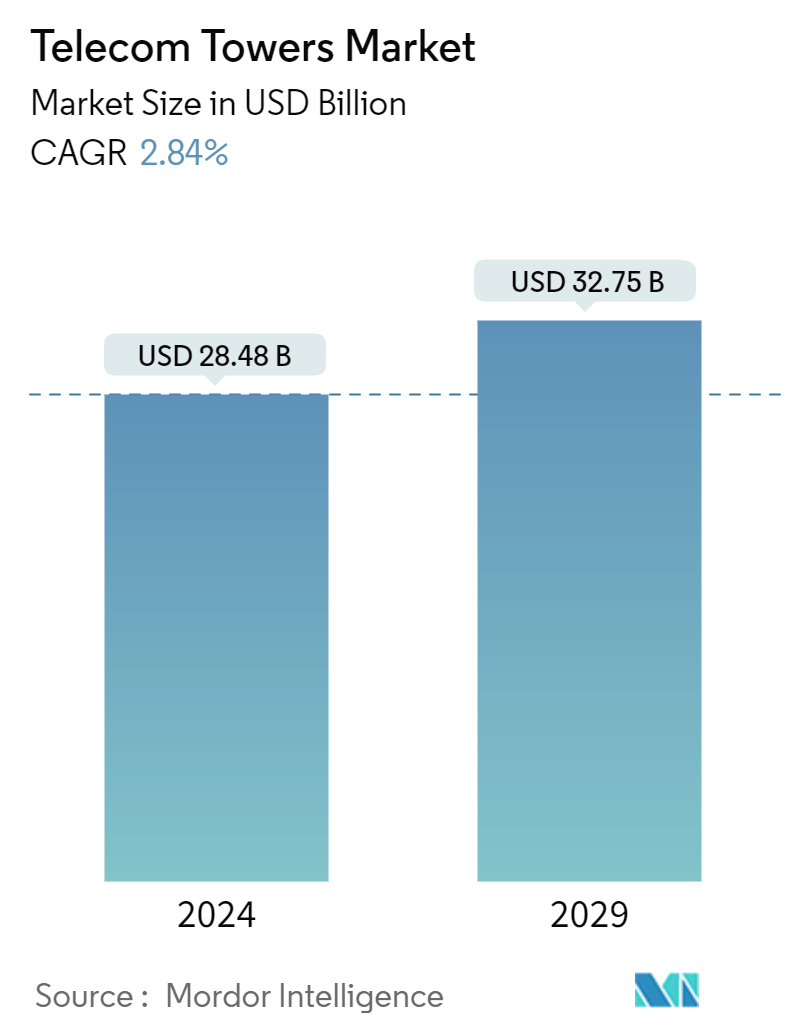
| Study Period | 2019 - 2029 |
| Market Size (2024) | USD 28.48 Billion |
| Market Size (2029) | USD 32.75 Billion |
| CAGR (2024 - 2029) | 2.84 % |
| Fastest Growing Market | Asia Pacific |
| Largest Market | Middle East and Africa |
Major Players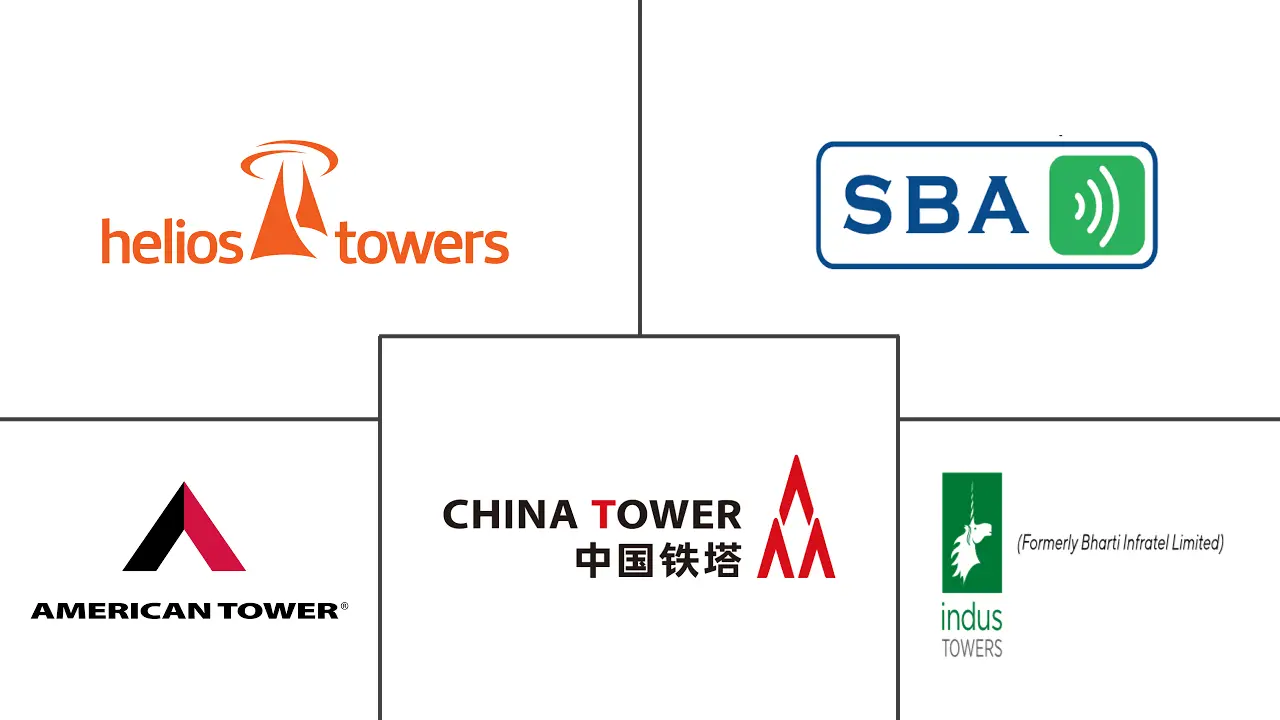
*Disclaimer: Major Players sorted in no particular order |
Telecom Towers Market Analysis
The Telecom Towers Market size is estimated at USD 28.48 billion in 2024, and is expected to reach USD 32.75 billion by 2029, growing at a CAGR of 2.84% during the forecast period (2024-2029).
The increasing penetration of high-speed internet services globally and the sharp rise in the number of smartphone and smart device users worldwide are some of the key driving factors expected to affect the growth trajectory of the global telecom tower market in the next years.
- Telecom towers are crucial in the 5G technology because telecom companies are learning that sharing and/or lending infrastructure is less expensive than starting from scratch, and tower businesses may provide the best bargains. Towercos are regaining importance as 5G networks' advantages necessitate a vast amount of additional infrastructure. This indicates that mobile network operators need to modernize, and investors are eager to identify fresh chances that could result in rapid returns in the 5G stock market.
- Moreover, tower businesses now have more opportunities for growth due to smart cities, and many of them are aiming to provide end-to-end communications infrastructure in the chosen cities. Towercos can provide various options for smart cities, including passive infrastructure, small cells, Wi-Fi, and fiber connectivity. Smart poles, which guarantee improved cellular coverage and enhance aesthetic value, have already begun to be installed by many tower firms. These poles can be leased to network operators and the government to install surveillance and traffic management systems and offer Wi-Fi and smart lighting services.
- The increasing emphasis on improving internet connectivity to rural areas is one of the major factors driving the deployment and improvisation of the telecom infrastructure in these areas, thereby aiding the market's growth.
- Telecom towers require an uninterrupted power supply to ensure 24x7 network availability, fulfilled mainly by electricity, batteries, and diesel generators. The environmental impacts of telecom towers have always been a significant concern. Radiation from mobile towers has been an important issue, and it is recognized as an unseen and subtle pollutant affecting life forms in multiple ways. Moreover, using non-renewable sources to run power systems, such as diesel, significantly pollutes the environment.
- With things returning to normalcy, the construction activities are set to return on track again. Overall, the telecom industry was among the major industries that experienced minimal impact from the COVID-19 pandemic. The primary region behind this was the significant increase in consumption of telecommunication services as more people started working from home and reliance on video conferencing to hold meetings increased. Most of the telecom operators in the region have reported an increase in their revenue due to this.
Telecom Towers Market Trends
Rooftop to Witness Growth
- Mobile network operators (MNOs) will need to make significant infrastructure investments for 5G to expand, and rooftop infrastructure will be essential to these investments. Building facades and rooftops are ideal real estate for MNOs wishing to densify their networks and expand their capacity or coverage. Antennas on the 5G network can deliver 5G signals straight to customers through a more significant line of sight on rooftops in an urban setting. In this approach, 5G reception can be reliably obtained by people and devices on the ground and close to the boundaries of surrounding buildings.
- As mobile network operators upsurge 5G capabilities, rooftops will play a key role. The growth of 5G will require massive infrastructural investment by mobile network operators (MNOs), and rooftop infrastructure is going to play a pivotal role in this investment. For instance, according to Ericsson, the rapid growth of 5G is expected over the coming years, with the number of subscriptions forecast to reach almost 4.7 billion by 2028.
- Moreover, in October 2023, DISH intended to install three antennas on the roof of the 16-story Residence Inn Hotel at 5 Barker Ave. in downtown White Plains. The Westage is behind the hotel at 25 Rockledge Ave. DISH Wireless installed wireless telecommunication antennas on a rooftop near the condo.
- According to American Tower Corp (ATC), large expenditures will be required from key stakeholders for the number of wireless transmission points, including base stations and small cells, to double to serve the 5G market. It was stated that the number of mobile towers in the nation would soon increase from 780,000 wireless transmission points to over a million. Such developments are expected to drive the market studied over the forecast period.
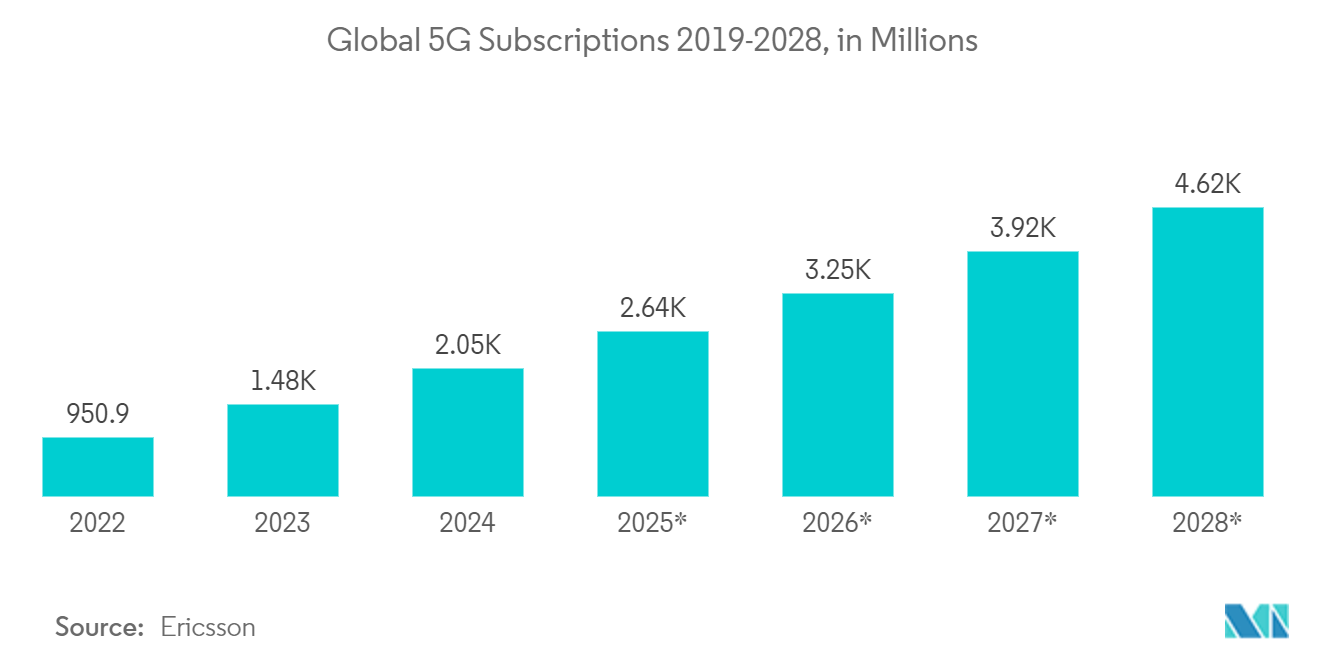
Middle East and Africa to Witness the Growth
- The region's telecom tower growth is primarily driven by the government's Saudi Vision 2030, as well as the development and extension of 5G mobile networks by major mobile network operators and the subsequent rise in mobile subscriptions.
- Saudi Arabia has transformed into a digital center and a provider in transitioning to 5G due to favorable laws, government funding, and initiatives. For instance, STC’s Mena HUB, a USD 1 billion investment in regional connectivity and infrastructure, will assist Saudi Arabia’s fast-growing digital and cloud industry.
- Seeking to build Digital Egypt and achieve the transition to a digital society, the Ministry of Communications and Information Technology (MCIT) has been working to build an infrastructure that is secure, reliable, and accessible.
- The Nigerian Communications Commission (NCC) developed robust Regulations and Guidelines or subsidiary laws for the telecommunications sector. One such regulation is the Guidelines on Technical Specifications for Installation of Masts and Towers, 2009. Companies installing telecom towers need to follow the regulations and guidelines for conducting smooth business in the country
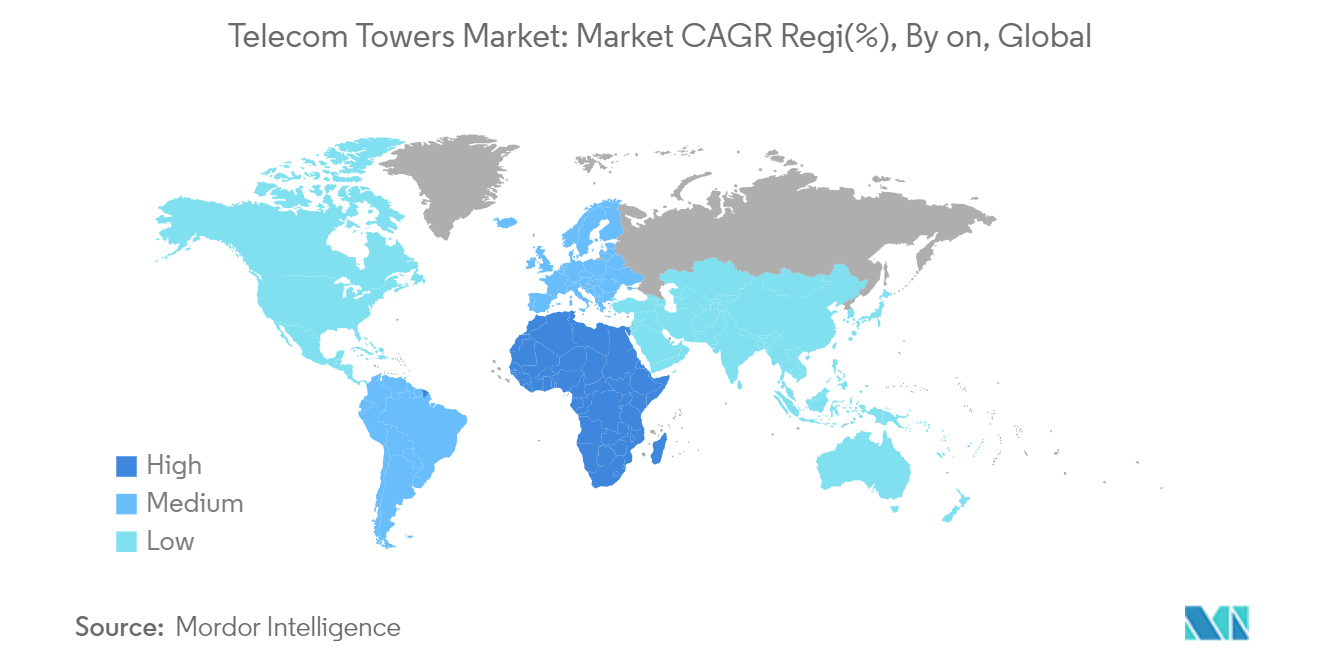
Telecom Towers Industry Overview
The telecom tower market is semi-consolidated and consists of several major players, such as American Tower Corporation, Helios Towers PLC, Indus Towers Limited (Bharti Infratel), China Tower Corporation, and SBA Communications Corporation. Only some significant players currently dominate the market in terms of market share. These major players in the telecom tower market are expanding their customer base internationally through strategic collaborations and acquisitions of telecom tower startups. This has led to a moderately high market concentration, with a few dominant players benefiting from significant market share and profitability.
- March 2024: Hi-COM Network Private Limited, a leading internet service provider, partnered strategically with Indus Towers Limited to enhance telecommunications infrastructure and advance sustainability initiatives. Indus Towers Limited, formed from the merger of Bharti Infratel Limited and Indus Towers, has provided robust infrastructure for the telecommunications sector. Through this collaboration, Hi-COM will leverage its expertise to assist Indus Towers in constructing new towers and upgrading existing ones to meet the increasing demands of the industry.
- January 2024: American Tower Corporation (ATC) announced a strategic collaboration with IBM to accelerate the deployment of a hybrid, multi-cloud computing platform at the edge. Through this collaboration, American Tower intends to expand its neutral-host, Access Edge Data Center ecosystem to include IBM Hybrid Cloud capabilities and Red Hat OpenShift. The two companies are set to work together to help clients address their evolving customer requirements and expectations around innovative digital transformation by enabling technologies such as IoT, 5G, AI, and network automation.
- December 2023: AT&T Inc. partnered with Ericsson to deploy a commercial-scale open radio access network (Open RAN). This collaboration aims to establish a robust ecosystem of network infrastructure providers and suppliers. The objective is to drive down network costs, enhance operational efficiencies, and facilitate sustained investments in the rapidly expanding broadband network.
Telecom Towers Market Leaders
-
American Tower Corporation
-
Helios Towers PLC
-
Indus Towers Limited (Bharti Infratel)
-
China Tower Corporation
-
SBA Communications Corporation
*Disclaimer: Major Players sorted in no particular order
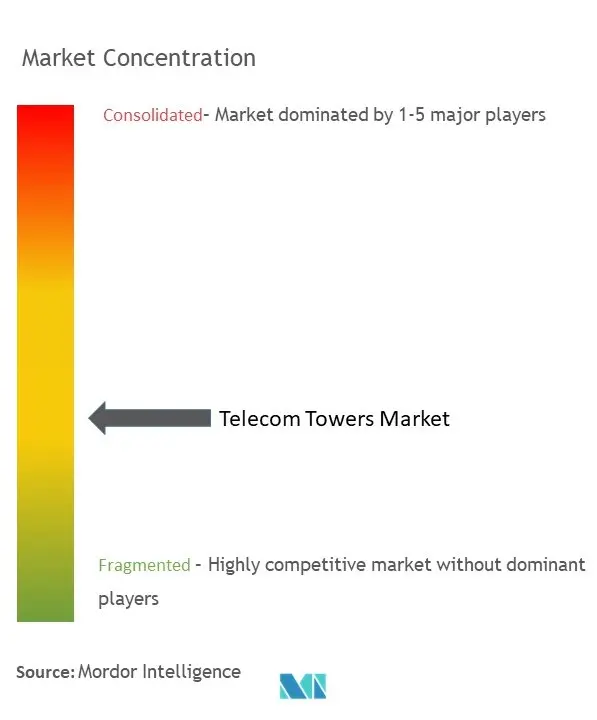
Telecom Towers Market News
- April 2024: TowerCo. of Africa Uganda secured USD 40 million in funding to expand coverage in the country's rural areas. The financing, to be disbursed over a 10-year period, comes from the European Investment Bank, the Development Bank of Austria (OeEB), and the Belgian Investment Company for Developing Countries. TowerCo. of Africa Uganda plans to install 506 new telecom towers strategically located in rural regions that currently lack mobile network access or where existing networks are saturated. These towers will provide rural communities access to 4G and 5G data services and mobile money solutions and promote financial inclusion.
- November 2023: Telxius partnered with the Firmina Subsea cable system. This system will connect the US East Coast to Las Toninas, Argentina, with additional landings in Praia Grande, Brazil, and Punta Del Este, Uruguay. Telxius will be hosting Firmina at its Santos digital hub in Brazil.
- August 2023: STC Group, a pioneer in digital transformation in the Middle East and Africa, announced that its subsidiary, TAWAL, had started its operations in Europe. The acquisition of the telecom tower assets of United Group in the Republic of Bulgaria, the Republic of Croatia, and the Republic of Slovenia, as part of STC’s strategy to grow and expand, and after all relevant regulatory approvals had been received. With the acquisition of the assets, TAWAL currently owns and operates more than 4.800 sites across three countries (Bulgarian, Croatian, and Slovenian) and provides operation services to new clients in those countries.
Telecom Towers Market Report - Table of Contents
1. INTRODUCTION
- 1.1 Study Assumption and Market Definition
- 1.2 Scope of the Study
2. RESEARCH METHODOLOGY
3. EXECUTIVE SUMMARY
4. MARKET INSIGHTS
- 4.1 Market Overview
-
4.2 Industry Attractiveness - Porter's Five Forces Analysis
- 4.2.1 Bargaining Power of Suppliers
- 4.2.2 Bargaining Power of Buyers
- 4.2.3 Threat of New Entrants
- 4.2.4 Threat of Substitutes
- 4.2.5 Intensity of Competitive Rivalry
5. MARKET DYNAMICS
-
5.1 Market Drivers
- 5.1.1 Connecting/Improving Connectivity to Rural Areas
- 5.1.2 Improving and Catering to Increasing Data Needs
-
5.2 Market Restraints
- 5.2.1 Environmental Concerns about Power Supply Systems to Towers
- 5.2.2 Tower-sharing between Telecom Companies
6. TECHNOLOGY SNAPSHOT
- 6.1 Technology Snapshot
7. MARKET SEGMENTATION
-
7.1 By Fuel Type
- 7.1.1 Renewable
- 7.1.2 Non-renewable
-
7.2 By Type of Tower
- 7.2.1 Lattice Tower
- 7.2.2 Guyed Tower
- 7.2.3 Monopole Towers
- 7.2.4 Stealth Towers
-
7.3 By Installation
- 7.3.1 Rooftop
- 7.3.2 Ground-based
-
7.4 By Ownership
- 7.4.1 Operator-owned
- 7.4.2 Joint Venture
- 7.4.3 Private-owned
- 7.4.4 MNO Captive
-
7.5 By Geography
- 7.5.1 North America
- 7.5.1.1 United States
- 7.5.1.2 Canada
- 7.5.2 Europe
- 7.5.2.1 United Kingdom
- 7.5.2.2 Germany
- 7.5.2.3 France
- 7.5.2.4 Italy
- 7.5.2.5 Spain
- 7.5.2.6 Netherlands
- 7.5.2.7 Sweden
- 7.5.2.8 Switzerland
- 7.5.2.9 Rest of Europe
- 7.5.3 Asia-Pacific
- 7.5.3.1 China
- 7.5.3.2 India
- 7.5.3.3 Japan
- 7.5.3.4 South Korea
- 7.5.3.5 Indonesia
- 7.5.3.6 Vietnam
- 7.5.3.7 Malaysia
- 7.5.3.8 Philippines
- 7.5.3.9 Australia and New Zealand
- 7.5.3.10 Rest of Asia-Pacific
- 7.5.4 Latin America
- 7.5.4.1 Brazil
- 7.5.4.2 Mexico
- 7.5.4.3 Argentina
- 7.5.4.4 Rest of Latin America
- 7.5.5 Middle East and Africa
- 7.5.5.1 Saudi Arabia
- 7.5.5.2 Egypt
- 7.5.5.3 Algeria
- 7.5.5.4 Nigeria
- 7.5.5.5 South Africa
- 7.5.5.6 Tanzania
- 7.5.5.7 Morocco
- 7.5.5.8 Rest of Middle East and Africa
8. COMPETITIVE LANDSCAPE
-
8.1 Company Profiles
- 8.1.1 American tower corporation
- 8.1.2 Helios Towers PLC
- 8.1.3 Indus Towers Limited (Bharti Infratel)
- 8.1.4 China Tower Corporation
- 8.1.5 SBA Communications Corporation
- 8.1.6 AT&T Inc.
- 8.1.7 T-Mobile US Inc.
- 8.1.8 GTL Infrastructure Limited
- 8.1.9 IHS Towers (IHS Holding Limited)
- 8.1.10 Tawal Com SA
- 8.1.11 Cellnex Telecom SA
- 8.1.12 Deutsche Funkturm GMBH (Deutsche Telekom Group)
- 8.1.13 Vantage Towers AG
- 8.1.14 Orange SA
- 8.1.15 Telenor ASA
- 8.1.16 ZZong Pakistan (China Mobile Limited)
- 8.1.17 Telkom Indonesia
- 8.1.18 Telxius Telecom SA
- 8.1.19 Telesites SAB de CV (OPSIMEX)
- *List Not Exhaustive
9. INVESTMENT ANALYSIS
10. FUTURE MARKET OUTLOOK
** Subject To AvailablityTelecom Towers Industry Segmentation
A telecommunication tower can be of any structure, including monopoles, tripoles, lattice towers, guyed towers, self-support towers, poles, masts, or similar structures. These towers support one or more telecommunication antennas, allowing radio communications. They can be placed on the ground or a building's rooftop, including equipment storage and storing electronic components. These towers do not require regular staffing and require periodic maintenance. The growth of telecom towers is set to continue during the forecast period, owing to the deployment of 5G infrastructure.
The telecom towers market is segmented by fuel type (renewable and non-renewable), type of tower (lattice tower, guyed tower, monopole tower, and stealth tower), installation (rooftop and ground-based), ownership (operator-owned, joint venture, private-owned, MNO captive), and geography (North America [United States and Canada], Europe (United Kingdom, Germany, France, Italy, Spain, Netherlands, Sweden, Switzerland, and Rest of Europe], Asia-Pacific [China, India, Japan, South Korea, Indonesia, Vietnam, Malaysia, Philippines, Australia and New Zealand, and Rest of Asia-Pacific], Latin America [Brazil, Mexico, Argentina, Central America, Columbia, and Rest of Latin America], and Middle East and Africa [Saudi Arabia, Egypt, Algeria, Nigeria, South Africa, Tanzania, Morocco, and Rest of Middle East and Africa]). The market sizes and forecasts are provided in terms of value (USD) for all the above segments.
| By Fuel Type | Renewable | |
| Non-renewable | ||
| By Type of Tower | Lattice Tower | |
| Guyed Tower | ||
| Monopole Towers | ||
| Stealth Towers | ||
| By Installation | Rooftop | |
| Ground-based | ||
| By Ownership | Operator-owned | |
| Joint Venture | ||
| Private-owned | ||
| MNO Captive | ||
| By Geography | North America | United States |
| Canada | ||
| By Geography | Europe | United Kingdom |
| Germany | ||
| France | ||
| Italy | ||
| Spain | ||
| Netherlands | ||
| Sweden | ||
| Switzerland | ||
| Rest of Europe | ||
| By Geography | Asia-Pacific | China |
| India | ||
| Japan | ||
| South Korea | ||
| Indonesia | ||
| Vietnam | ||
| Malaysia | ||
| Philippines | ||
| Australia and New Zealand | ||
| Rest of Asia-Pacific | ||
| By Geography | Latin America | Brazil |
| Mexico | ||
| Argentina | ||
| Rest of Latin America | ||
| By Geography | Middle East and Africa | Saudi Arabia |
| Egypt | ||
| Algeria | ||
| Nigeria | ||
| South Africa | ||
| Tanzania | ||
| Morocco | ||
| Rest of Middle East and Africa |
Telecom Towers Market Research FAQs
How big is the Telecom Towers Market?
The Telecom Towers Market size is expected to reach USD 28.48 billion in 2024 and grow at a CAGR of 2.84% to reach USD 32.75 billion by 2029.
What is the current Telecom Towers Market size?
In 2024, the Telecom Towers Market size is expected to reach USD 28.48 billion.
Who are the key players in Telecom Towers Market?
American Tower Corporation, Helios Towers PLC, Indus Towers Limited (Bharti Infratel), China Tower Corporation and SBA Communications Corporation are the major companies operating in the Telecom Towers Market.
Which is the fastest growing region in Telecom Towers Market?
Asia Pacific is estimated to grow at the highest CAGR over the forecast period (2024-2029).
Which region has the biggest share in Telecom Towers Market?
In 2024, the Middle East and Africa accounts for the largest market share in Telecom Towers Market.
What years does this Telecom Towers Market cover, and what was the market size in 2023?
In 2023, the Telecom Towers Market size was estimated at USD 27.67 billion. The report covers the Telecom Towers Market historical market size for years: 2019, 2020, 2021, 2022 and 2023. The report also forecasts the Telecom Towers Market size for years: 2024, 2025, 2026, 2027, 2028 and 2029.
What are the emerging trends in the Telecom Towers Market?
Emerging trends in the Telecom Towers market are a) Adoption of renewable energy sources for power management b) Deployment of small cells c) Integration of Artificial Intelligence (AI) for tower management
Telecom Towers Industry Report
The global telecom tower market is experiencing robust growth, driven by the increasing demand for high-speed internet and widespread adoption of smartphones and smart devices. Key market segments include monopole, lattice, stealth, and guyed towers, catering to different environmental and regulatory requirements. The market also features diverse ownership types, ranging from telecom operator-owned to joint ventures and private ownership, and installation types like ground-mounted and rooftop towers, addressing unique urban and rural needs. The Asia Pacific region leads this expansion, with significant investments in telecommunications infrastructure and rapid deployment of technologies like 5G and IoT. Telecommunication tower companies and telecom tower companies are actively expanding their infrastructure to manage rising data traffic and enhance connectivity. The cell tower industry is adapting to environmental challenges by integrating renewable energy sources and innovative designs to minimize impacts. For detailed statistics, market share, size, revenue growth rate, and a forecast outlook of the Telecom Towers market, download a free report PDF from Mordor Intelligence™ Industry Reports.



